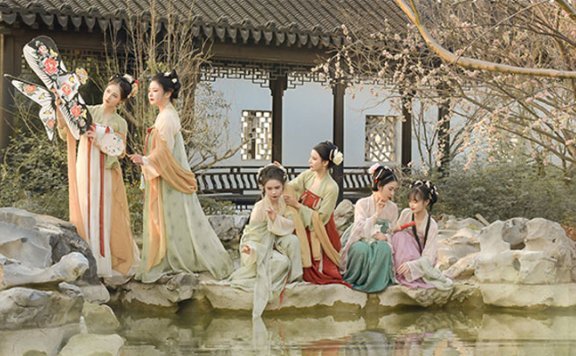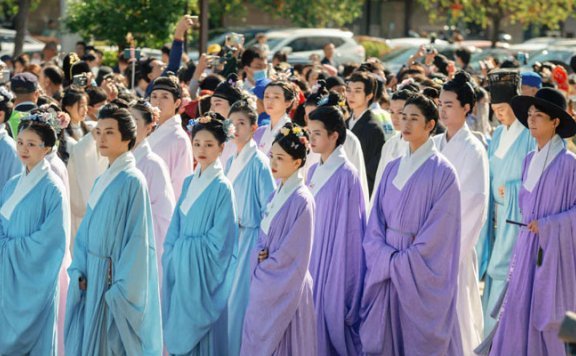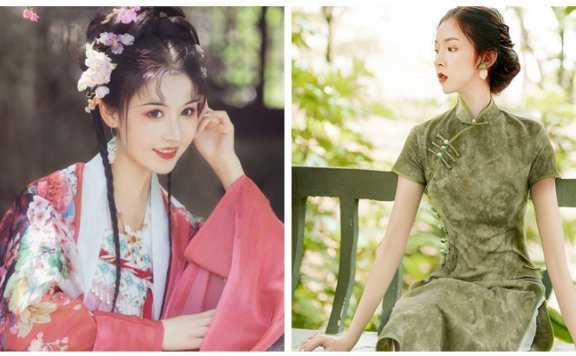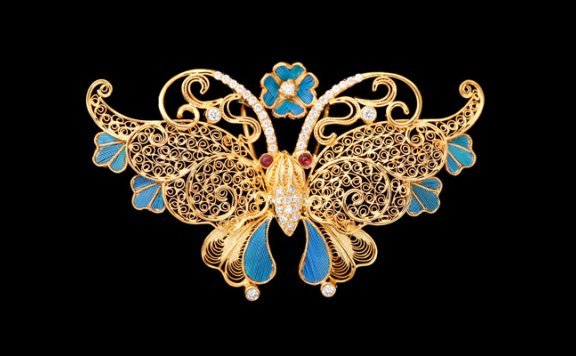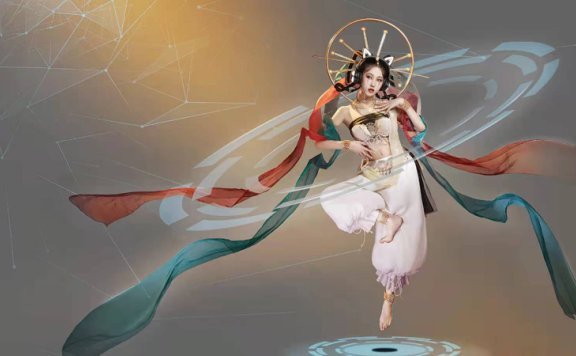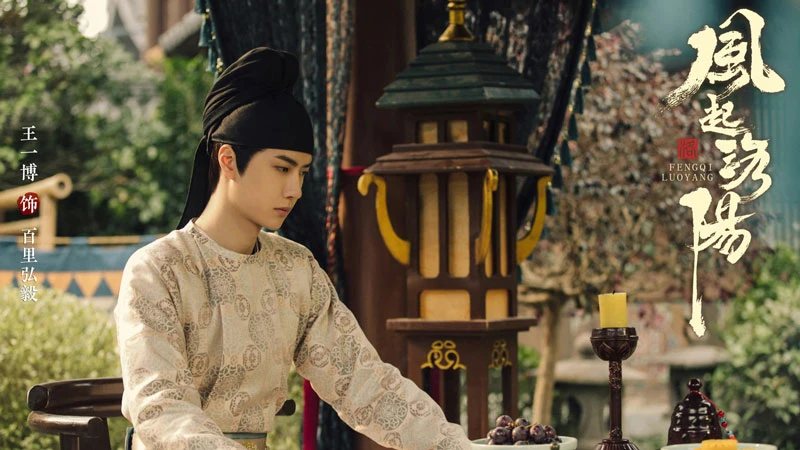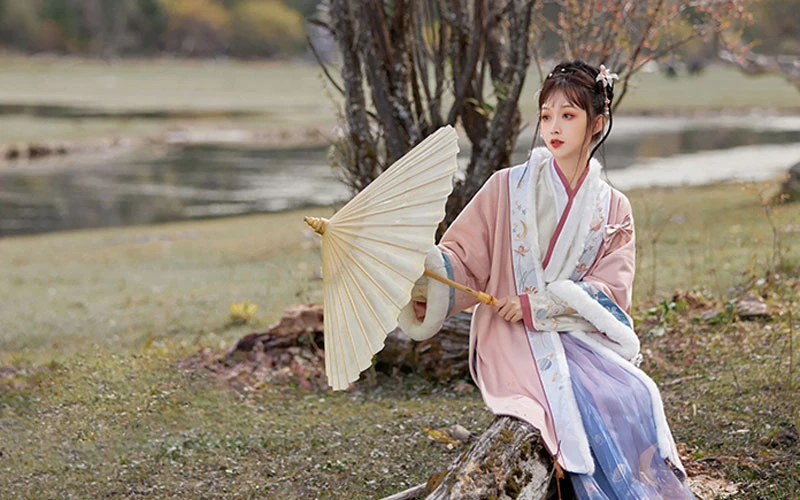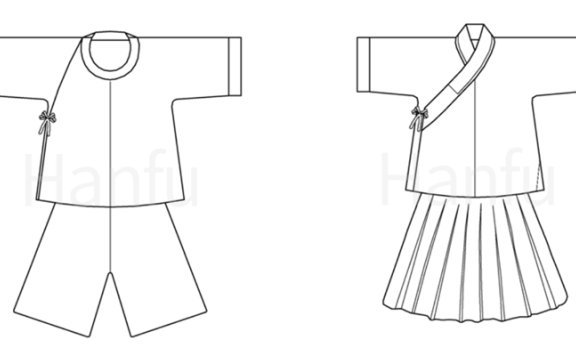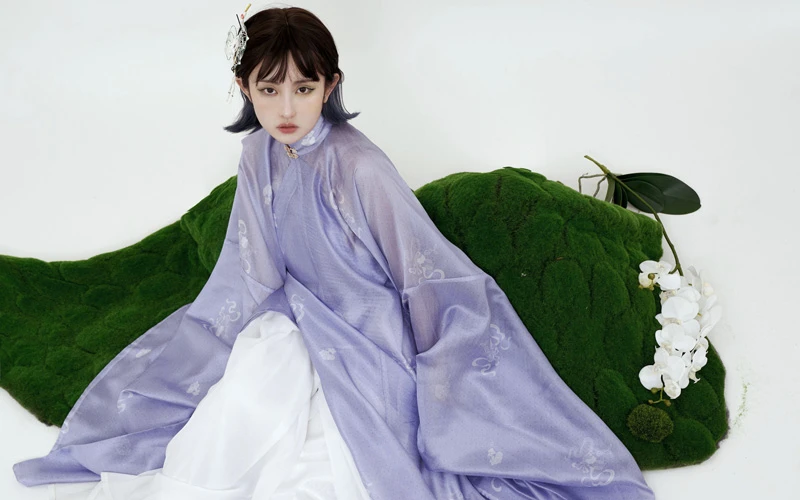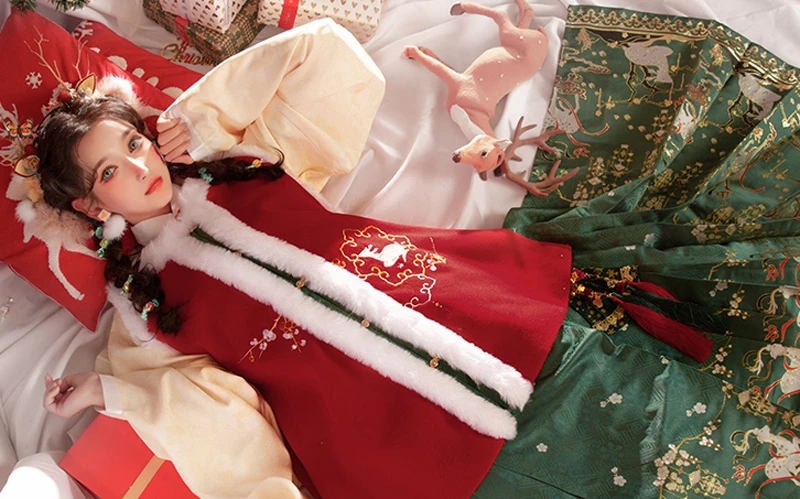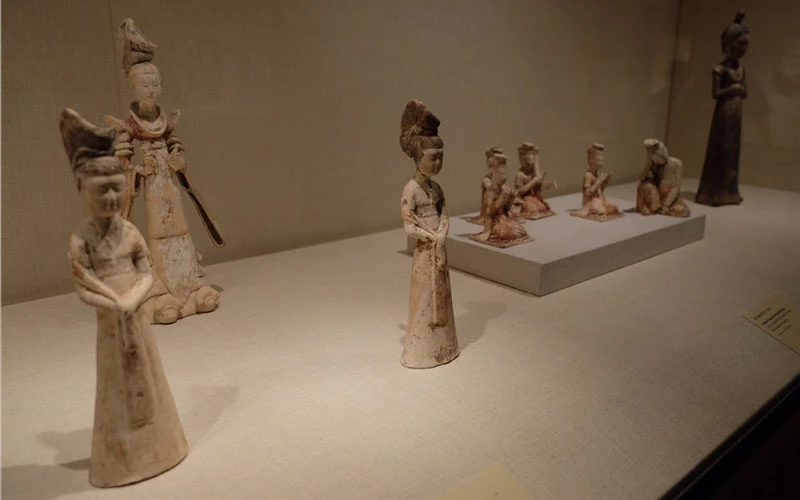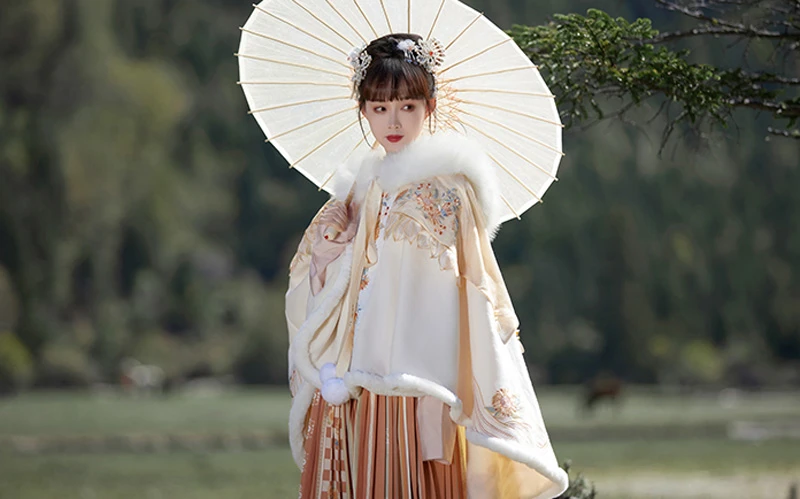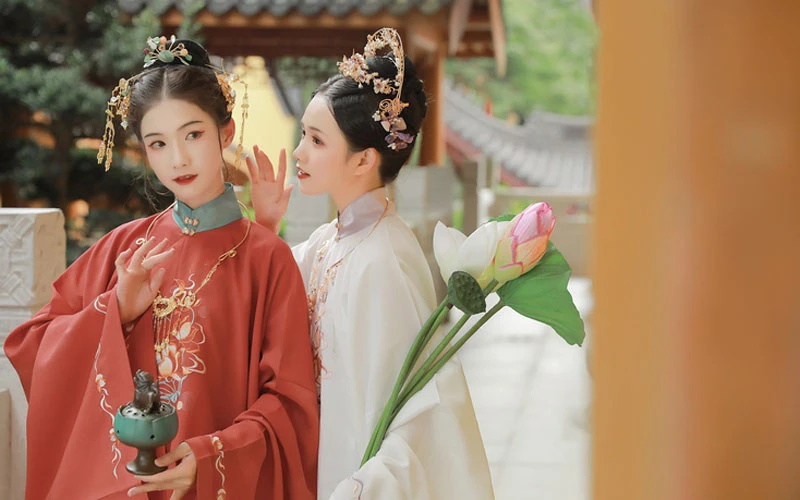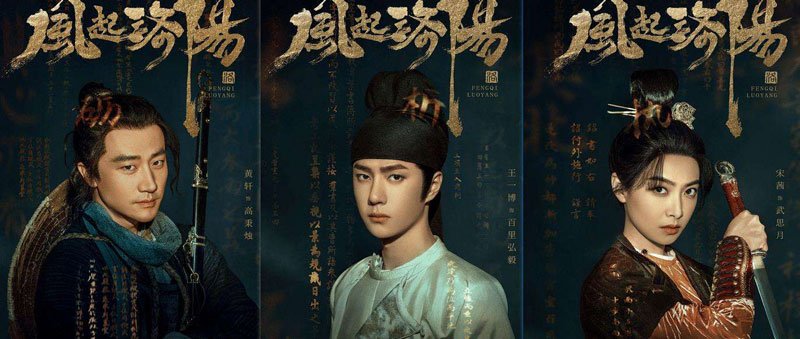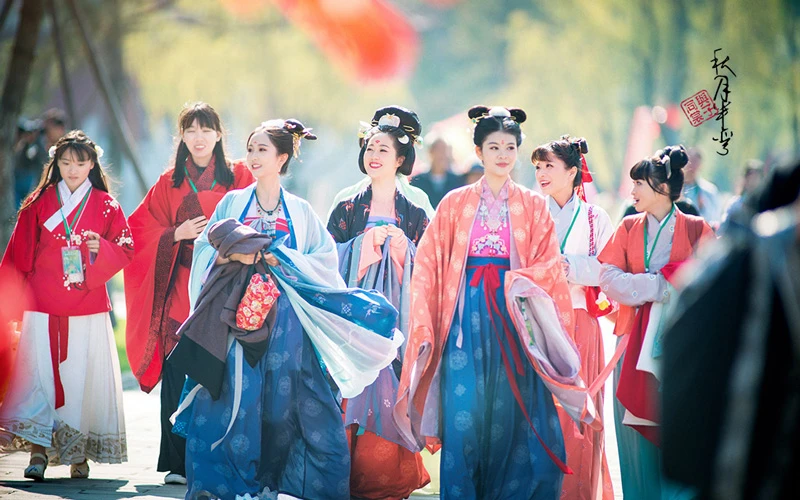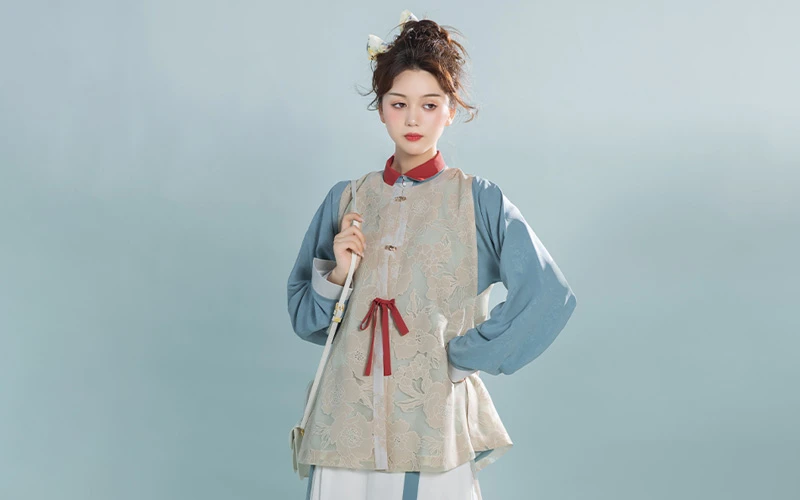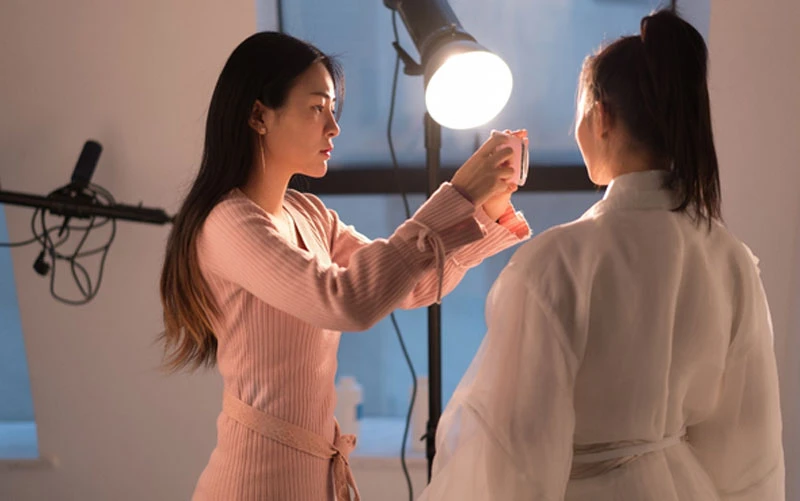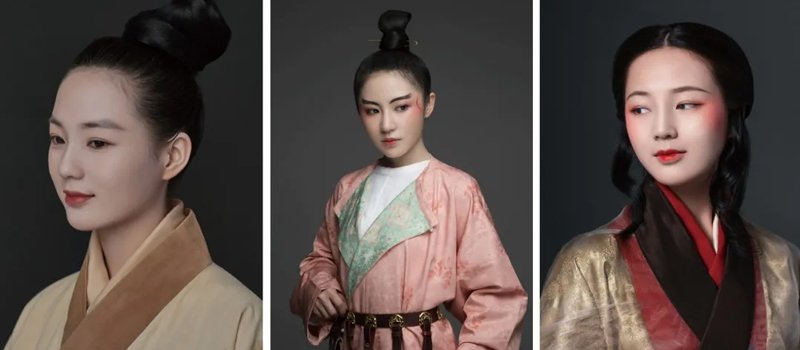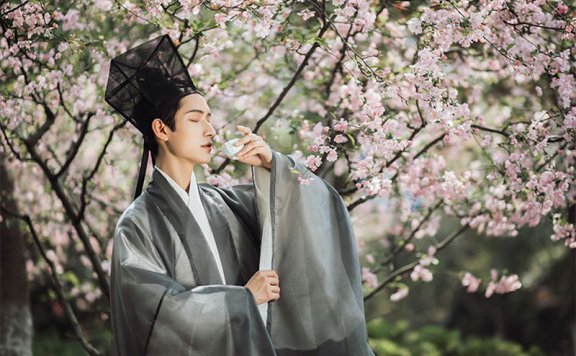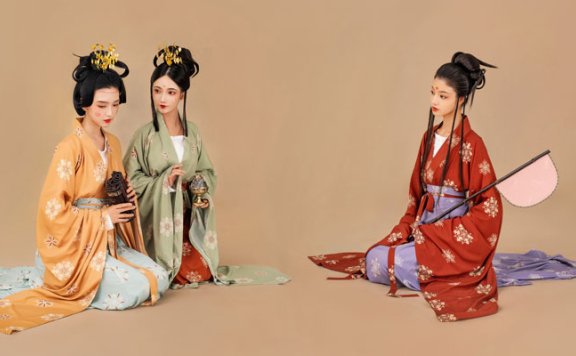Article
搜索结果:
-
Top 10 Traditional Chinese Outfits Loved by Hanfu Fans 2021
Have you bought hanfu in 2021? Which hanfu styles are your favorite? Here's a list of the popular traditional Chinese outfits - hanfu of 2021 for you. Includes 4 Tang Dynasty hanfu, 1 Song Dynasty hanfu, 5 Ming Dynasty hanfu. Tang Style 1 Each color scheme is super fresh, the whole body is Tencel chiffon fabric, skin-friendly and comfortable, drape enough, the upper body is thin, suitable for spring and summer season. 2 This set of Tang Beizi's print fresh and elegant, inside the round neck shirt goose yellow solid color, thin, not suitable for single wear. One-piece inter-color skirt, skirt printed with gold flower pattern, the whole set of fresh and elegant and more everyday. 3 Unlike other Tang style hanfu dresses, this style is more colorful, with a multicolor inter-color skirt plus a two-color blouse with a dark pattern underlining, the whole is understated and lively, full of details. 4 Qixiong Shanqun style has always been popular. And broadcast of drama "The Long Ballad" and "Luoyang", also set off a tang wind boom. The overall fresh and elegant, soft chiffon fabric, light and breathable, drape enough. Song Style 5 The whole set of… -
5 Important Hanfu Festivals That Hanfu Lover Must Konw
The number of Hanfu festivals and Hanfu events has gradually risen over the past decade or so of Hanfu revival. Not only in China, but also around the world, Hanfu enthusiasts organize hanfu day from time to time. Hanfu events are not only an important channel for more people to learn about hanfu, but also a great way for Hanfu lovers to meet like-minded people and discuss traditional culture together. In this article, we have compiled 5 relatively important hanfu festivals (hanfu day) for you. Flower Festival (花神节) The Flower Festival, commonly known as the "Flower God Festival", is held on the second day of the second month of the lunar calendar. Wearing hanfu is one of the traditional customs to celebrate the festival. The Flower Festival is a very important traditional folk festival in Han Chinese. The exact timing is related to the early or late flowering season in different places. Whenever it comes to the Flower Festival, hanfu lovers will wear hanfu and hold a ceremony to worship the Flower God. Chinese National Costume Day (Hanfu Day) The Chinese National Costume Day (华服日), also known as Hanfu Day, is celebrated on the third day of the… -
Hanfu vs Qipao, Cheongsam: What’s the Difference?
Hanfu vs Qipao, both are excellent representatives of traditional Chinese costumes. Hanfu (汉服), Han national traditional costume. Qipao (旗袍, cheongsam), the women's clothing of the Republican era. Whenever traditional Chinese clothing is mentioned, the cheongsam is usually the first thing that comes to mind. But with the expanding influence of Hanfu, a costume that better represents Chinese history is being preferred by more and more people. What exactly are the differences between the two costumes? 1. Hanfu vs Qipao in Different Origins Origin of Hanfu Ancient hanfu was the traditional clothing and accessory system of the Han Chinese from the time of the Yellow Emperor to the middle of the 17th century AD (late Ming and early Qing dynasties). Origin of cheongsam Cheongsam was formed in the 1920s and later became the most common women's clothing at that time, being one of the most splendid phenomena and forms in China's long-standing dress culture. The controversy of the origin of cheongsam There are still many controversies about the definition of cheongsam and the time of its production, focusing on the following. 1. It is believed that cheongsam is developed directly from the robe of Qing Dynasty. 2. It is believed… -
History of Chinese Traditional Filigree Inlay Art
The magnificent filigree inlay, representing the pinnacle of precious metal production technology, from the old days dedicated to the court, to nowadays spread to the folk, there has been a lot of people contact, wear filigree inlay products, and for its exquisite and intricate technology by. What is Filigree Inlay? Filigree inlay (花丝镶嵌), also known as "fine gold craft", is a long-established traditional Chinese handicraft technique, mainly used in the production of ancient Chinese royal jewelry, by the combination of "filigree" and "inlay" two production techniques. Filigree refers to drawing gold and silver into fine wire, using filling and weaving techniques to make crafts. Inlay refers to the hammering of gold and silver flakes into vessels, and then burin out the pattern, set with pearls or gemstones, and become. As one of the "Eight Unique Skills of Yanjing", the art of filigree mosaic was included in China's national intangible cultural heritage list in June 2008. The objects that can be applied with filigree inlay can be divided into three categories. The first category is jewelry, including bracelets, necklaces, earrings, brooches, pendants, cufflinks, etc. The second category is the display category, mainly indoor decorative items, such as hanging scroll, vase,… -
Hanfu in 2077? Post-95 Girl Made Cyberpunk Style Chinese Clothes
The inspiration for this set of photos came from a Qing Dynasty Qianlong porcelain now in the National Museum of China. It was made in Jingdezhen for Haiyan Hall in the Yuanmingyuan Park, and only one survives. The whole artwork contains the meaning of "the sea is calm and the river is clear, and the country is peaceful", and is beautifully crafted and painted, symbolizing the peak of the Qianlong period porcelain! On top of that, this blogger combines traditional elements with cyberpunk style, combining ancient national treasures with futuristic science fiction, a cyan Qing costume, a beautiful Tian-tsui crown, and golden nail guards to show luxury! The focus is on some details of the face, the appearance of the two swallows decorated, the face of the painted lines are all exquisite and sharp, just a few strokes to highlight the taste of the future of technology! Such a creative realization, the effect is really great! And this is not the only wonderful work of this treasure blogger, today we will introduce you to @Lao Ba (老八捌) and her fantastic creations! Hanfu + Futuristic Elements Ideas The idea of combining traditional hanfu with technology and the future has been… -
5 Reasons Why Was Cdrama Fengqi Luoyang Such a Huge Hit?
Have you watched the cdrama "Fengqi Luoyang" yet? In recent days, it has ushered in the final ending, as the last surprise in 2021, Fengqi Luoyang can be described as a good drama with a conscience to interpret the oriental aesthetics. https://youtu.be/WLoLXjZec5s The following we from the scene, props, costumes, makeup, and other dimensions in the drama to see how "Fengqi Luoyang" is outstanding. Scene in Fengqi Luoyang "Fengqi Luoyang" is about a suspenseful story that takes place in the ancient city of Luoyang during the Tang Dynasty, three different classes of Luoyang people work together to solve the case, looking to reveal the truth behind the scenes, and the plot is fast-paced. In order to restore the divine capital of the Tang Dynasty Luoyang, the art scenes of the whole drama are set with great care, each frame is as beautiful as a picture. The important scenes in the drama are all built in real, covering a total area of over 40,000 square meters, with more than 100 restored scenes. The 14,000 square meters of the Nanshi, the streets and alleys, a brick and a tile are all efforts, feel the creative team of the ancient Luoyang city… -
10 Must-have Hanfu Warm Long Beizi for Winter
Today we will take stock of the good shape, design thin, easy matching Song dynasty long Beizi. Beizi fabric is single-sided tweed, embroidered lapels with inserts, stars and moon embroidery combines traditional embroidery techniques with fashion elements. The lapel cuffs are inlaid with plush trim, full of girlie feeling. Pink body with light blue lapels, the color is light and fresh. Tweed Beizi cuffs are embedded with white wool strips and embroidered elegantly. The overall color scheme is fresh, and a golden swallow and rabbit are embroidered on each side of the front, making it lively and vivid. A small piece of suede patch embroidery is added to the placket, adding a lovely winter feel with the fur strips on the sleeves. The tweed fabric of Beizi is warm and thick, and this Beizi is more suitable for everyday and can be worn as regular wear. The embroidery can be said to be just right. The light blue color scheme really looks super gentle. Beizi lining feels smooth and the plush is soft and delicate, and it is windproof and warm. The edge of the endings are also edged with plush, both practical and beautiful. The… -
Hanfu Making(13) - Improved Hanfu Cutting & Sewing Patterns
This section contains improved Hanfu (改良汉服). Please read the introduction of the topic and how to use this guide in advance. Introduction Wearing hanfu is not just for the sake of retro and vintage, but also to show classical beauty and promote the traditional culture of the nation. However, many people have misconceptions about hanfu, believing that the process of wearing hanfu is tedious and that it is not convenient to move around after wearing it. In fact, hanfu is not necessarily a wide robe with big sleeves. The hanfu system itself contains short and slim tops, as well as short-sleeved and narrow-sleeved types of clothing. The hanfu tops can be matched with modern skirts and pants with a little improvement of the form, as long as the shape and color match. The "improvement" referred to here is not to develop to Western-style three-dimensional cutting, but to make certain modifications to the hanfu pattern, such as reducing the sleeve length and cuff width, and making slight modifications to the shape to make it more suitable for matching with modern clothing, combining tradition with fashion, while maintaining the basic shape and flat cutting method of hanfu. It is hoped that this improved… -
How to Match Pantone's Color of 2022 - Very Peri in Your Hanfu
Since the epidemic, what exactly is the color that can give a refreshing feeling? PANTONE gave their answer: Very Peri, which has a very beautiful Chinese name 长春花蓝 (periwinkle blue). How to integrate it in your 2022 hanfu wear, follow Han Time to find out. Pantone's Color of 2022 - Very Peri Just a few days ago, PANTONE announced the color of the year 2022, Very Peri. Very Peri is not a conventional color, but a blend of more than two colors. Perhaps it is the presence of the fantasy personality of Metaverse and the color of COVID-19, but it gives it a sense of the times to rise to the occasion and meet the newness of everything. Some people call it purple-blue, simple and straightforward, but also shows that it is between blue and purple, a blend of purple elegance, blue quiet. In fact, this color also carries a sense of haze, which makes people fall into it. Very Peri, should be a representative of warmth and sensuality. In China, periwinkle is kind of a greenhouse flower, like sunshine, fear of moisture, if maintain the appropriate temperature and ventilation, then the four seasons can be planted. In the… -
4 Christmas Elements Hanfu Styling Ideas for 2021
It's Christmas soon, and everywhere is full of cheerful atmosphere! Today, we'll share with you 4 Christmas-themed hanfu. The design of styling one is very ingenious, the combination of bunny and Christmas elements, especially cute and festive. The Bijia with fluff has a sense of winter atmosphere. The dark green Mamian Qun, with the theme of "deer, plum blossoms, and lanterns", looks great. Bijia's fur trim design is very unique, is the feeling of moose. Christmas deer pattern is very delicate. Mamian Qun also uses the Christmas elements, super in line with the scene, the overall sense of atmosphere full! This Ming Hanfu set is mainly in green color, and there is a cute little embroidery of Christmas elements on the body, which is cute and eye-catching. The lower skirt with white woven gold Mamian, both the atmosphere and suitable for daily wear. -
A Guide to Identifying the Hairstyles of Tang Dynasty Female Figurines
In museums, we can often see many female figurines from the Tang Dynasty. In this article, we will select some of the common female figurines to introduce their hairstyles. Duo Ma Ji (堕 马 髻) Duo Ma Ji is perhaps one of the most familiar hairstyles of the Tang Dynasty. In fact, this name already appeared in the Han Dynasty, but the exact form of Duo Ma Ji in the Han Dynasty is still uncertain. The name was used during the Tang Dynasty to describe a bun that was tilted to one side. The shape of the Duo Ma Ji is the hair falls between the ears and is combed towards the face, and the bun is not located in the middle of the head, but to the side. It is also known as the "Pao Jia Ji". This kind of bun is especially common in the late Tang Dynasty. In the famous "Lady Guoguo's Spring Outing", you can see the image of woman wearing the Duo Ma Ji. Wo Duo Ji (倭堕髻) Wo Duo Ji also has the form of double sideburns holding the face, with single or multiple buns placed on top of the head from… -
7 Cute and Comfy Winter Hanfu Outfits in 2022
Fear of cold in winter, but still want to wear beautiful hanfu, add a Pi Ao or Doupeng in your winter hanfu outfit, wind-resistant and warm. LOOK1 Straight collar half-sleeve Pi Ao Gemstone velvet fabric, relatively soft, several colors are quite suitable for winter, the design is relatively simple, suitable for daily wear, can be matched with fashion dress. LOOK2 Square/round collar Pi Ao Match with a Mamian Qun to easily reflect the temperament and gentle feeling. LOOK3 Long square collar Pi Ao This cuffs hairy edge is also very winter feeling. As a jacket to wear inside can also wear thicker clothes, everyday and gentle! LOOK4 Velvetted straight collar half-sleeve Pi Ao Red color really gives a very energetic feeling in winter. When it snows and New Year's Eve, it's perfect to wear. The cuffs fur edge is also cute! LOOK5 Straight collar half-sleeve Pi Ao The style design is simple and generous, and can be easily matched with different Ming Dynasty dresses. Doupeng style is more or less the same, if you feel that the ordinary thickness is not warm enough, you can choose thickened, so that even if it is snowing,… -
What is the Ming Dynasty Hanfu Clothing?
Ming Dynasty Hanfu clothing refers to the clothing system in the Ming Dynasty (1368-1644). At the beginning of the Ming Dynasty, Zhu Yuanzhang, the founder of the Ming Dynasty, inherited the costume style of Zhou, Han, Tang, and Song Dynasties and re-established the costume system in order to rebuild the national pride and etiquette and remove the influence of ethnic minorities. In the middle and later period of the Ming Dynasty, there were some new styles, such as stand collar, and a large number of buttons were used in the conspicuous part of a garment. It was gradually banned during the Qing Dynasty, but there are still a few styles and features that have been handed down to this day. The characteristics of Hanfu in the Ming dynasty In the Ming Dynasty, a series of measures were taken to develop production, which made the industry and commerce develop continuously, and the production technology of each industry has improved. After the rise of the citizen class, the aesthetic interest has become the aesthetic orientation of the general dress in the Ming Dynasty. "Secularization" of the aesthetic and cultural sources and a relatively general, casual, and loose historical and cultural environment.… -
Cdrama Wind from Luoyang - A Dream Through the Millennium
To the north of Jianchunmen Street in Luoyang, there is a place called "South Market", which is the most prosperous place in Luoyang City. A middle-aged man with his daughter is weaving through the bustling crowd, seeing the Hu merchant from the West with a camel, the man wearing traditional robe and Futou, the woman wearing a western regions style dress. This is the first big scene of the recently launched mystery cdrama "Luoyang (风起洛阳, Wind from Luoyang)". The style of the ancient Luoyang capital of the 13th dynasty a thousand years ago, the visual impact brought by various aspects of architecture, costumes, furnishings, and details of life, has created a dream for contemporary people to travel through the millennium. The suspenseful and brain-burning setting coupled with the fine quality of the episodes, the high degree of completion has driven the audience to expect. This fills a rich undercurrent for the prosperous dream of Luoyang. At a time when traditional culture is becoming more popular and more influential, the audiovisual requirements of viewers for related film and television content are rising. This is an important reason why "Wind from Luoyang" has previously received much attention. With the launch of the… -
How Chinoiserie Culture Quietly Popular Among Young People
Hairpins, earrings, brooches, bracelets, and other antique jewelry in a wide range, tweezers, wire drawing board, spitfire, and other tools filled the workbench. In the studio of "Jia Xu Zao Wu (甲戌造物)" located in Jinan, Shandong Province, "post-90s" young man Lü Jikai is using the millennium-old filigree inlay craft to process custom traditional jewelry for customers. Among the popular culture in China in recent years, the ancient trend represented by hanfu, cheongsam and traditional jewelry is especially sought after by young people like Lü Jikai. More and more "post-90s" and "post-00s" have turned their love for Chinese costumes and traditional jewelry into a career, becoming the promoters of the Chinoiserie culture. "8 years ago, when I first joined the industry, the demand for traditional jewelry is not high, and few people do it, like the old craft of filigree inlay, but few people know." Lü Jikai said. But in recent years, traditional Chinoiserie culture is receiving more and more attention, oriental aesthetics get more young people like, traditional Chinese jewelry also began to capture the hearts of more consumers. "In the past, only a few orders a month, now the orders are basically scheduled to three months later.Some people specify… -
Winter Hanfu Outfit Ideas Without Looking Bulky
In winter, Hanfu lovers have turned their attention to the Ming dynasty style hanfu outfit. The Liling (立领, standing collar) has become the mainstay in the Ming style hanfu, and has become the most popular among the girls, together with the dignified and generous Mamian Qun (马面裙, horse face skirt), a set of elegant Ming hanfu styling is completed. But in winter, want to wear layers and not show bulky, Bijia (比甲) item can not be missed. Bijia is a sleeveless, collarless vest with openings on both sides of the lapel and below the knee. Its style is usually longer than later vests, usually up to the hips or to the knees, and some are longer, less than a foot above the ground. This style of clothing was originally a hanfu style from the Song Dynasty, with a long sleeveless blouse, also called a "Beixin (背心)". Later, it was introduced to Mongolia. Bijia is generally worn outside the large-sleeved shirt, or coat, and skirt underneath, which can be easily matched to show a sense of layering. By the late Mongolian Yuan, the Han Chinese women in the north especially like this style. Since the Yuan Dynasty has buttons, it is… -
Dang Xiao Shi|Tell the World How Beautiful Hanfu Are With the Camera
If there existed a chronology of hanfu revival in Chengdu, it would include Lü Xiaowei, who founded China's first hanfu store in 2006 - Chong Hui Han Tang. And, the female photographer who launched the "Travel with Hanfu" campaign online in 2014, Dang Xiao Shi (当小时). She became popular because of hanfu, and was controversial because of hanfu, and now this highly individualistic oriental photographer has put down her camera, and returned with the oriental element brand "Xu Mi Ge (须弥阁)". Controversial for taking beautiful hanfu photos Born in Chengdu, Sichuan province, 33-year-old Dang Xiao Shi, looking back on her love affair with Chinese hanfu costume, she is overwhelmed with emotion. In 2014, Dang Xiao Shi was invited by a friend to travel to Nepal to take her wedding anniversary photos. Dang Xiao Shi, who was already well known in the hanfu community, proposed a hanfu theme, considering the novelty of the subject matter, and to her surprise, the photos caused a stir as soon as they were released. Immediately afterward, Dang Xiao Shi started the "Travel with Hanfu" campaign. She traveled to Iceland, Spain, Italy, and 14 other countries with her hanfu. However, as Dang Xiao Shi's popularity… -
The Evolution of Traditional Chinese Makeup Culture
About the ancient Chinese women's makeup, how ancient women actually groomed themselves? We don't really know. History has left many questions about traditional Chinese makeup: What did the real Yang Guifei look like? How did the pearl makeup of the Northern Song Dynasty evolve? What do the Ehuang, Huadian, and Yuanshan eyebrows refer to? In August, the book "The Beauty of Chinese Makeup (中国妆容之美)" was published. The book shows the makeup of women from the pre-Qin Dynasty to the Qing Dynasty, in which 29 groups of real restored makeup charts are particularly eye-catching, from hair to jewelry, from lip color to eyebrow shape, every detail, after informative testimony. One of the authors of this book, Chen Shiyu (陈诗宇), who is the costume consultant for National Treasures and Serenade of Peaceful Joy, has been engaged in the research of ancient Chinese costume restoration and crafts research for more than ten years. In his eyes, the process of restoring ancient figures looks is like solving a case, complicated but fun. In the program "National Treasure", Princess Wencheng played by Yang Zi and the Ya Ya played by Tong Liya, broke the inherent impression of people for the women of the… -
5 Classic Hanfu Sleeve Types in Ming Dynasty
When it comes to the gracefulness and elegance of hanfu, the sleeves must take at least half of the credit for the gesture. I believe the deepest impression of Chinese hanfu costumes is that they have wide sleeves. In fact, types of hanfu sleeves are not only wide sleeves, but they also vary in width, length, and posture, so I wonder which "sleeve posture" is most to your liking? Large sleeve Large sleeves (大袖), also known as the wide sleeve, or what we commonly call the "wide sleeve", is known for its wide sleeve width, with the width of the cuff even approaching the sleeve length. It is the most classic sleeve shape of Hanfu, and also the most "fairy" one. The pose of "wide clothes and large sleeves" is the most common in hanfu dresses. Because it is inconvenient to work, it is mostly reserved for the upper class and is often a symbol of etiquette. However, due to changes in the system, status, wearing occasions, socio-economic culture, and other factors, the same large sleeves have different forms. Among the Ming official uniforms, the large sleeves of the "Chaofu (朝服)" and "Gongfu (公服)" was relatively wider, with… -
How to Match the Northern and Southern Dynasties Hanfu
Unlike the Han, Tang, Song, and Ming dynasties, the Wei, Jin, Northern and Southern dynasties, were the most frequent period of regime change in Chinese history, mainly divided into the Three Kingdoms: Cao Wei (曹魏), Shu Han (蜀汉) and Dong Wu (东吴); Western Jin (西晋); Eastern Jin (东晋); the Northern and Southern Dynasties periods (南北朝时期). The development of Chinese culture during this period was particularly affected by the long period of feudalism and continuous wars. As a result of the interplay of many new cultural factors, the Northern and Southern Dynasties became a tumultuous but poetic era, with the amorous style of a flamboyant gentleman and the leisurely thoughts of a gentle girl. In a simple and bright move under the skirt, there is a unique "Northern and Southern Dynasties" hanfu flavor, and the poetry of the oriental landscape is linked in the softness and simplicity. In this article, let's take a closer look at the unique aesthetic of this era and teach you how easy it will be to match the "Northern and Southern Dynasties Hanfu" with a classical flavor. The style trend of hanfu in the "Northern and Southern Dynasties" During the Northern and Southern Dynasties, hanfu…
